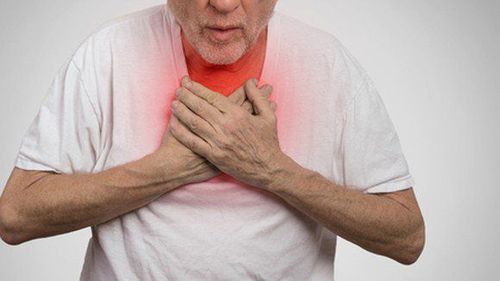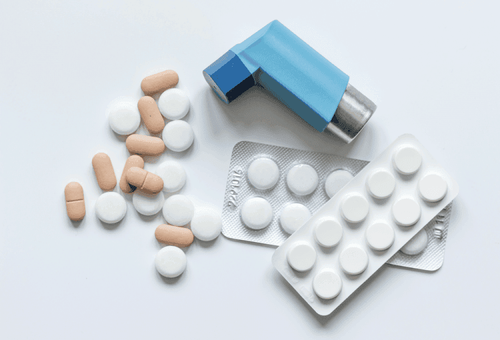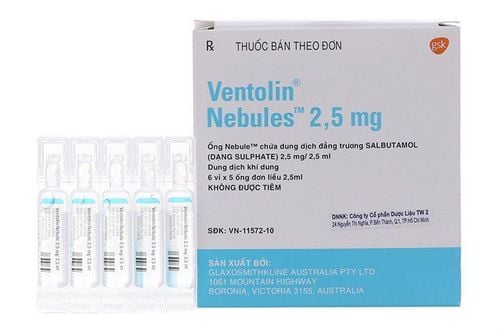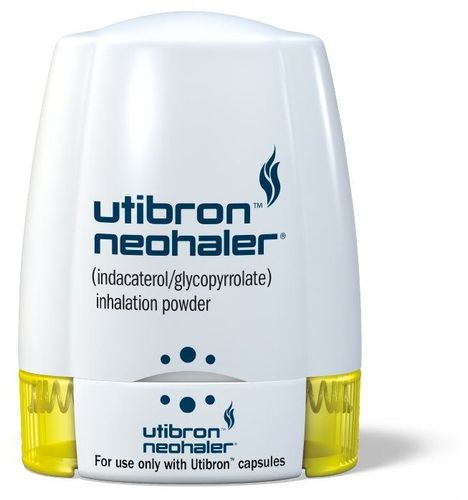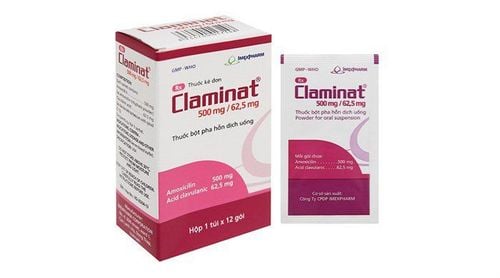This is an automatically translated article.
An exacerbation of chronic obstructive pulmonary disease is a condition in which acute respiratory symptoms change from stable to sudden worsening, affecting lung function and requiring a change in regimen. conventional treatment.
1. Acute exacerbation of chronic obstructive pulmonary disease
An exacerbation of chronic obstructive pulmonary disease (COPD) is a medical condition in which acute respiratory symptoms change from a stable phase of the disease to a sudden worsening of the disease. This negatively affects lung function, requiring a change in the usual treatment regimen. Besides, exacerbations are not detected early, delaying treatment, leading to severe disease prognosis.
People with chronic obstructive pulmonary disease are subject to an exacerbation of chronic obstructive pulmonary disease, common warning signs for an outbreak are difficulty breathing, wheezing, shallow or rapid breathing, worsening cough, increased heart rate or temperature, and a change in the color of sputum. Patients with chronic obstructive pulmonary disease may have one or two exacerbations per year, and these tend to get worse over time. Risk factors and triggers leading to exacerbations:
Cigarette smoking or passive smoking, frequent exposure to secondhand smoke. Living and working in an environment containing a lot of dust and pollution. Older people (>40 years old), increasingly declining lung function is also one of the risk factors.
2. Common symptoms in acute exacerbation of chronic obstructive pulmonary disease
The lungs are responsible for exchanging oxygen (O2) with carbon dioxide (CO2) to carry out the body's life cycle, with people with chronic obstructive pulmonary disease will face more difficulty in this metabolism because The lungs are not working properly. This can lead to a build-up of carbon dioxide and a decrease in oxygen levels. If CO2 accumulates in the body too much or the oxygen level becomes too low, this can lead to death.
The most obvious sign of an impending exacerbation is difficulty breathing. The patient feels as if the chest is strangled, the amount of air received is not enough. This can happen even with light physical activity or while resting. Some other symptoms to watch out for:
Shortness of breath: The patient cannot breathe comfortably, the shortness of breath is increasing gradually. Wheezing: The patient presents with wheezing, which indicates that mucus or pus is blocking the airway. Chest tightness: You feel like you're using your chest muscles to breathe instead of your diaphragm. Your breathing is irregular, your chest moves sometimes faster, sometimes much slower. Cough: Cough occurs frequently and gradually increases in severity. The patient may have a dry cough or a cough with yellow or green sputum mixed with blood. The disease worsens when lying down, the patient needs to change position or sit in a chair to make it easier to breathe. Skin or nail color change: The patient's lips are bluish or the fingernails are blue or purple. The patient's skin is yellow or gray. Difficulty sleeping and eating: Patients are prone to insomnia, unable to sleep and not wanting to eat. Early morning headaches: Headaches can be explained by excess carbon dioxide build-up in the blood. Swollen legs or abdominal pain: These symptoms are related to heart or lung problems. Fever: Fever can be considered a sign of infection and an impending new exacerbation.

Khó thở là triệu chứng thường gặp trong đợt cấp bệnh phổi tắc nghẽn mạn tính
3. Causes of exacerbations of chronic obstructive pulmonary disease
The most direct and most common cause, accounting for more than 80% of exacerbations, is infection (superinfectious COPD), which can be viral or bacterial.
Common viruses: Rhinovirus, Influenza, Parainfluenza, Coronavirus (Covid 19), Respiratory Syncytial Virus (RSV), Human Metapneumomia Virus, Adenovirus, Picornaviruses,... Common bacteria: Haemophilus Influenzae, Moraxella Catarrhalis, Staphylococcus Aureus, Streptococcus Pneumoniae,... Besides, some other causes can cause exacerbation of chronic obstructive pulmonary disease related to:
Medical factors: patients with pulmonary embolism or pneumothorax , respiratory muscle fatigue, drug withdrawal, improper drug use or regimen. Patients using sedatives, beta-blockers, anesthetics, cardiac arrhythmias, metabolic disorders, infections of other organs,... Surgical factors: Fractures, thoracic trauma , after abdominal and chest surgery. About 33% of cases have no known cause.
4. Diagnosis of acute exacerbation of chronic obstructive pulmonary disease
According to the Anthonisen criteria, exacerbations usually occur in patients who have been diagnosed with chronic obstructive pulmonary disease and suddenly develop one or more of the following symptoms:
Increased dyspnea. Sputum production increased. Change in color of sputum. With or without other systemic symptoms such as fever, chest pain, loss of consciousness, etc. Besides, the doctor will base on signs of exacerbation to diagnose and treat. Some clinical signs:
Respiratory: dyspnea at rest, cyanosis, SPO2<88%, accessory respiratory muscle contractions, paradoxical chest and abdomen movements, respiratory rate >25, ineffective cough Cardiovascular: heart beat more than 110 beats/min and irregular heartbeat, pallor, edema of lower extremities Excitement, disturbance of consciousness Blood gases: PaO2 < 55 mmHg, PaCO2 > 45 Patients with a history of long-term home oxygen therapy , with accompanying diseases: cardiovascular disease, alcoholism, damage to the nervous system.
5. Complications of exacerbation of chronic obstructive pulmonary disease
With chronic obstructive pulmonary disease, depending on the severity of the disease, the stage of the disease, which group of diseases will have an appropriate treatment regimen. For patients with exacerbations, it is imperative to change the treatment regimen. Through studies, the rate of exacerbations occurring is about 0.85 - 3 episodes/patient/year. The average number of days of an exacerbation per patient ranges from 12-14 days/patient/year. Especially, 60-70% of people with chronic obstructive pulmonary disease have an exacerbation within 2-4 years. Therefore, it can be seen that acute exacerbations are very common, controlling or choosing the optimal treatment regimen will limit the incidence of exacerbations.
For patients with frequent exacerbations, it will lead to an increase in respiratory diseases, a decrease in quality of life, an increase in treatment costs, an increase in the rate of decline in respiratory function and a serious illness. progression, severe cases can lead to death. The more exacerbations a patient has, the higher the mortality rate. In addition, the survival rate of patients after the exacerbation gradually decreased over time. In a multi-center study, synthesizing 25 centers around the world, the study showed that over 1000 patients who experienced an exacerbation of chronic obstructive pulmonary disease, the patient's survival rate decreased to 50.7% after 2 years. Thus, the prognosis of respiratory function decreases, air trapping increases, especially in hospital infections, multi-resistant bacteria increase.
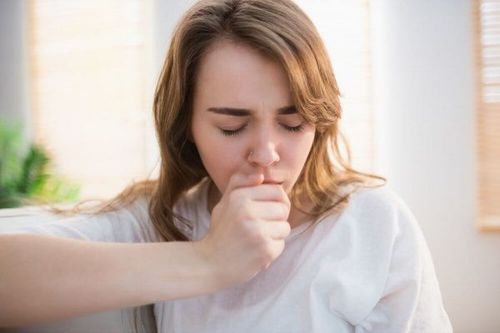
Chẩn đoán đợt cấp bệnh phổi tắc nghẽn mạn tính khi có triệu chứng khạc đờm tăng
6. Methods of treatment
Obstructive lung disease is a chronic disease, currently there is no treatment to completely cure the disease, but early examination and treatment can help improve and control symptoms for patients. then the patient can live a comfortable and comfortable life like a normal person.
Accordingly, the treatment of acute exacerbation of chronic obstructive pulmonary disease is a combination of drugs and therapeutic exercises such as cough and sputum exercises, breathing exercises to restore respiratory function. Besides, quitting smoking and staying away from sources of secondhand smoke are also very important in the effectiveness of treatment and limit the severity of the disease.
Chronic obstructive pulmonary disease can also be treated at home, but patients need to strictly adhere to the treatment regimen and limit exposure to risk factors, and have regular check-ups every 6 months. /time. If there are signs of a more serious illness such as shortness of breath, coughing a lot, the patient should immediately go to a respiratory clinic for timely treatment. To prevent exacerbations from occurring in COPD patients, the definitive treatment of the exacerbation is to optimize bronchodilators and inhaled corticosteroids.
7. Prevention of exacerbations of chronic obstructive pulmonary disease
Exacerbations cannot be completely prevented, but people can reduce the severity and frequency of exacerbations in the following ways:
Avoid exposure to triggers that can cause irritation lungs such as mold, smoke, coal, fuel oil, etc. Limit exposure in crowded places, especially in cold winter to prevent flu infection or respiratory diseases. Drink plenty of water to clear the airways and at the same time make the mucus thinner not become too thick, obstructing breathing. Get a flu shot every year to prevent flu and respiratory infections, some other vaccines like whooping cough, pneumococcal are recommended to be effective for people with COPD. Influenza and pneumonia are predisposing factors for exacerbation of chronic obstructive pulmonary disease. Maintain and strictly adhere to the treatment regimen for chronic obstructive pulmonary disease and have regular check-ups with a specialist to ensure health. Practice and practice good habits for yourself, like getting enough sleep at night and eating healthy according to a nutritious diet. Quit smoking or stay away from secondhand smoke. Wash your hands often and use hand sanitizer to prevent the spread of bacteria. Eat a reduced-fat, varied nutrient-rich diet, get plenty of rest, and do light exercise appropriate to your health when possible. If the patient performs well and fully with the above-mentioned solutions, it is possible to control the number and severity of exacerbations of chronic obstructive pulmonary disease. With a mild recurrence of COPD exacerbations, you can be safely treated as an outpatient and with minimal hospitalizations. Besides, active lifestyle changes are one of the effective measures to help reduce symptoms of diseases in general and of chronic obstructive pulmonary disease in particular. Some exercises help improve health for people with COPD such as walking regularly every day, doing exercises to improve fitness, especially breathing exercises that are good for the respiratory system. .
To summarize, an exacerbation of chronic obstructive pulmonary disease is a condition in which acute respiratory symptoms change from a stable phase of the disease to a sudden worsening of lung function that requires pulmonary function. There is a change in the usual treatment regimen. Patients with chronic obstructive pulmonary disease can lead a comfortable life and effectively prevent exacerbations if treated according to the regimen and instructions of the doctor, and combined with a scientific lifestyle, eating and drinking. and exercise properly. In addition, regular health check-ups every 6 months is a good measure to prevent diseases and detect health abnormalities early.
Please dial HOTLINE for more information or register for an appointment HERE. Download MyVinmec app to make appointments faster and to manage your bookings easily.




